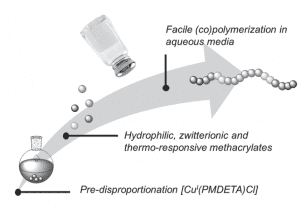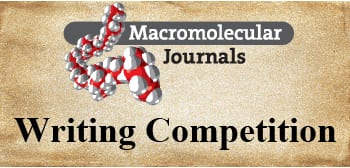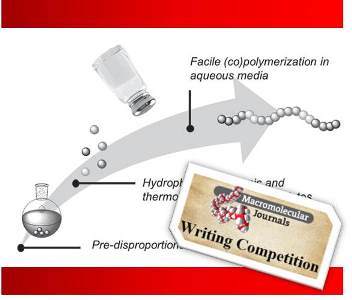by Katrin-Stephanie Tücking (Universität Siegen)
 Synthetic polymers enable the design of well-defined molecules for various applications. Controlled, so-called living polymerization techniques like RAFT (reversible addition-fragmentation chain transfer) or ATRP (atom transfer radical polymerization) are common synthetic techniques to generate functional (co)polymers with a narrow molecular weight distribution (MWD).
Synthetic polymers enable the design of well-defined molecules for various applications. Controlled, so-called living polymerization techniques like RAFT (reversible addition-fragmentation chain transfer) or ATRP (atom transfer radical polymerization) are common synthetic techniques to generate functional (co)polymers with a narrow molecular weight distribution (MWD).
The highlighted article from Haddleton and coworkers describes a synthetic strategy for the synthesis of methacrylic zwitterionic, thermoresponsive and hydrophilic (co)polymers via copper-mediated polymerization within short time. The synthesis of zwitterionic polymers via controlled living polymerization needs to be studied more extensively, because these polymers have a high potential for bioapplications due to their antifouling properties. The key steps for these well-designed methacrylic polymers relies on the predisproportionation of an in situ formed metal-ligand complex like [CuI(PMDETA)Cl] as well as the addition of supplementary halide salts, e.g. NaCl. The copper catalyst allows good control over the polymerization for low and medium conversions, but a MWD broadening is still visible for high conversions of the monomer. The addition of a halide salt source narrows down the MWD as low as Ð = 1.3 for poly[poly(ethylene glycol)methyl ether methacrylate] (PEGMA475) by reducing the extent of complex dissociation. The halide salt should contain the same halogen as the Cu-complex to avoid unsatisfactory halogen-exchange. Metal-ligand catalyzed polymerizations retain the end-group fidelity even for block copolymers of acrylamides and (meth)acrylates at high conversions without additional purification steps. In aqueous media low dispersities (1.05 < Ð < 1.38) at quantitative conversions can be achieved.
In their recently published article, Simula et al. investigate controlled polymerizations at quantitative conversions (>99%) for a wider range of monomers like functional methacrylates and zwitterionic monomers. The optimization of the synthesis relies on two crucial points: the ratio of initiator (I) to ligand (L) to Copper(I) halide (CuIX) and the halide salt concentration. For a defined ratio of I:L:CuIX applies the general rule: the higher the salt concentration, the lower the dispersity (Ð) of the polymer for the same degree of polymerization. As a consequence, very short polymerization times from 30 minutes for high molecular weight PEGMA (up to Mn ≈ 60 000 g*mol-1) to 2.5 h for functional telechelic polymers were sufficient.
 We would like to thank all participants in the Macromolecular Journals Writing Competition.
We would like to thank all participants in the Macromolecular Journals Writing Competition.
The best contributions are now featured on MaterialsViews and will go into the draw for the iPad mini. The winner will be drawn at the Macromolecular Colloquium, February 2016 in Freiburg and will be informed by email.
We hope you enjoy reading the news articles from our young talents.

















